
The red telephone box, a telephone kiosk for a public telephone designed by Sir Giles Gilbert Scott, is a familiar sight on the streets of the United Kingdom, Malta, Bermuda and Gibraltar.

The Museum of the Home, formerly the Geffrye Museum, is a free museum in the 18th-century Grade I-listed former almshouses on Kingsland Road in Hoxton, London. The museum's change of name was announced in 2019. The museum explores home and home life from 1600 to the present day with galleries which ask questions about 'home', present diverse lived experiences, and examine the psychological and emotional relationships people have with the idea of "home" alongside a series of period room displays.

North Dulwich railway station is in the London Borough of Southwark in Dulwich, south London. The station and all trains serving it are operated by Southern, and it is on the boundary of Travelcard Zone 2 and Travelcard Zone 3.

Richmond Green is a recreation area near the centre of Richmond, a town of about 20,000 inhabitants situated in south-west London. Owned by the Crown Estate, it is leased to the London Borough of Richmond upon Thames. The Green, which has been described as "one of the most beautiful urban greens surviving anywhere in England", is roughly square in shape and its open grassland, framed with broadleaf trees, extends to roughly twelve acres. On the north-east side there is also a smaller open space called Little Green. Richmond Green and Little Green are overlooked by a mixture of period townhouses, historic buildings and municipal and commercial establishments including the Richmond Lending Library and Richmond Theatre.
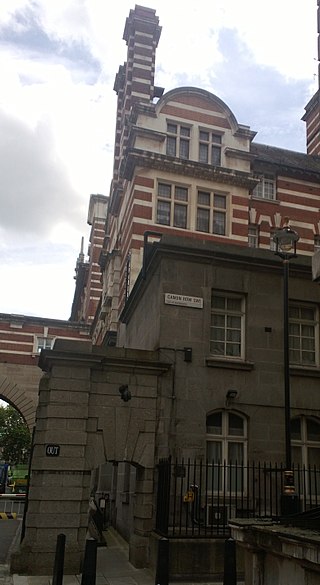
Canon Row Police Station in Canon Row, Westminster, was one of the Metropolitan Police's better known central London police stations. Replacing a leased station on King Street in St James's, it opened on 21 July 1902 in an extension to the Norman Shaw Buildings, then the home of New Scotland Yard. Canon Row Police Station was designed by the Metropolitan Police Surveyor, John Dixon Butler, with Richard Norman Shaw as consultant. The building is listed at Grade II*, and is no longer in use as a police station.

Bow Road is a thoroughfare in Bow, London, England. The road forms part of the A11, running from Aldgate to Norwich in Norfolk. To the west the road becomes Mile End Road, and to the east is Bow Interchange on the A12.

Christleton is a civil parish in Cheshire West and Chester, England. It contains 32 buildings that are recorded in the National Heritage List for England as designated listed buildings. Of these, three are listed at Grade II*, and the others at Grade II. The largest settlement in the parish is the village of Christleton, and most of the listed buildings are in the village. These include houses with related structures, the church and items in the churchyard, almshouses, a memorial shelter, and a telephone kiosk. The Shropshire Union Canal passes through the parish, and three of its bridges are listed. Also listed is a former hydraulic sewage lift.
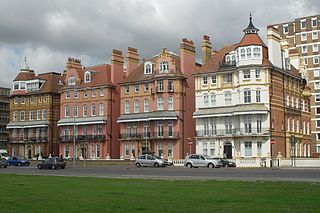
As of February 2001, there were 1,124 listed buildings with Grade II status in the English city of Brighton and Hove. The total at 2009 was similar. The city, on the English Channel coast approximately 52 miles (84 km) south of London, was formed as a unitary authority in 1997 by the merger of the neighbouring towns of Brighton and Hove. Queen Elizabeth II granted city status in 2000.
Blackburn is a town in Lancashire, England. It contains 72 buildings that are recorded in the National Heritage List for England as designated listed buildings. Of these, five are listed at Grade II*, the middle grade, and the others are at Grade II, the lowest grade. Until the coming of the Industrial Revolution, Blackburn was a market town, but then became a centre of the cotton industry. The Leeds and Liverpool Canal came to the town in 1806, and the Blackburn and Preston Railway opened in 1846. Following this there was a boom on the building of mills, with associated housing and the creation of civic buildings.
Croston is a civil parish in the Borough of Chorley, Lancashire, England. The parish contains 47 buildings that are recorded in the National Heritage List for England as designated listed buildings. Of these, one is listed at Grade II*, the middle grade, and the others are at Grade II, the lowest grade. The parish contains the village of Croston, and this is surrounded by agricultural land. Passing through the parish are the River Yarrow and the new cut of the River Douglas. Most of the listed buildings are farmhouses, farm buildings, and houses, some of which originated as farmhouses. The other listed buildings include churches, almshouses, a village cross, public houses, a school, bridges, a former rectory and associated structures, and a telephone kiosk.

Ye Olde Cherry Tree is a grade II listed public house on the corner of The Green and The Mall in Southgate, north London, which dates from around 1695.
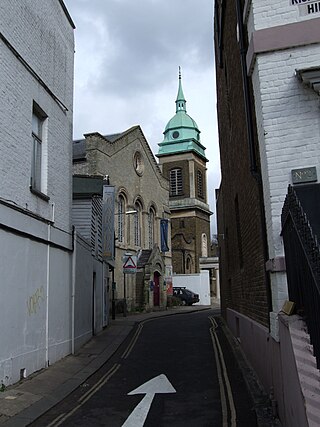
The Vineyard is a street in Richmond, in the London Borough of Richmond upon Thames. It includes three groups of almshouses, a Grade II listed church and Clarence House, a 17th-century Grade II listed house associated with Bernardo O’Higgins, who is commemorated on the wall of the property with a blue plaque, installed by English Heritage, for his role in the Chilean War of Independence.
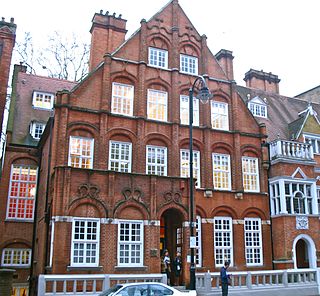
Harrington Gardens is a street which has a communal garden regionally sometimes known as a garden square in the Royal Borough of Kensington and Chelsea in London. The street runs from Collingham Gardens and Collingham Road in the east to Gloucester Road and Stanhope Gardens in the west. It is crossed by Ashburn Place and joined by Colbeck Mews on its north side. It contains several listed buildings including an important group of grade II* buildings on the south side numbered 35 to 45.
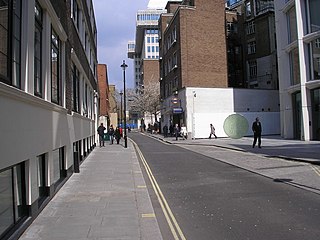
Palmer Street is a street in the City of Westminster in London that runs between Petty France in the north and Victoria Street in the south. It is crossed by Caxton Street and Butler Place. The lower half of Palmer Street, below Caxton Street, is pedestrianised.

The Westminster Almshouses Foundation is based at Palmers House, 42 Rochester Row, London. Its building is a grade II listed building.

Southgate Street is one of the ancient streets in the City of Gloucester, so named because its southern end was originally the location of the south gate in the city's walls. The part beyond the gate as far as Severn Street was sometimes known as Lower Southgate Street. It runs from the crossroads of Northgate, Eastgate, Southgate, and Westgate Streets in the north to Bristol Road in the south.

John Dixon Butler was a British architect and surveyor who had a long, professional association with London's Metropolitan Police. During his 25-year career with the police, he completed the designs and alterations to around 200 police buildings, including ten courts; as of 2022, about 58 of his buildings survive. Historic England describes him as "one of the most accomplished Metropolitan Police architects" and have included around 25 of his buildings on the National Historic List of England and Wales.
Ledsham is a civil parish in the metropolitan borough of the City of Leeds, West Yorkshire, England. The parish contains twelve listed buildings that are recorded in the National Heritage List for England. Of these, two are listed at Grade I, the highest of the three grades, and the others are at Grade II, the lowest grade. The parish contains the village of Ledsham and the surrounding countryside. Most of the listed buildings are in the village, and consist of houses and farmhouses, almshouses, a former orphanage, a former school, a church, a former vicarage with a walled garden, and a telephone kiosk. Outside the village, to the north is a former hunting lodge, and to the south are the ruins of a manor house.

The Charing Cross Trunk Murder took place in a third floor office at 86 Rochester Row in the City of Westminster in London on 4 May 1927.
















